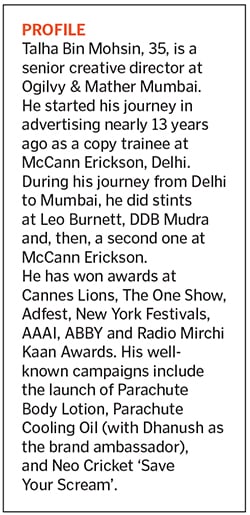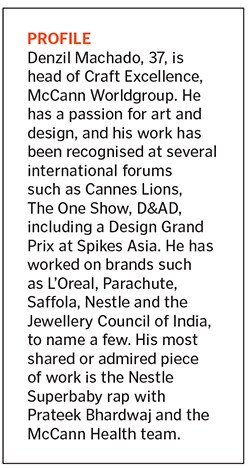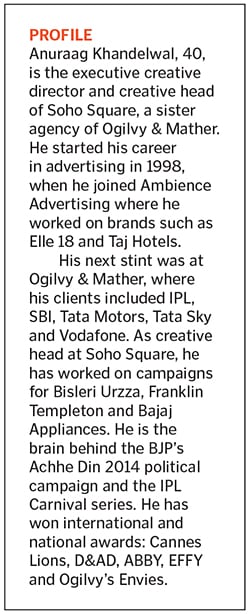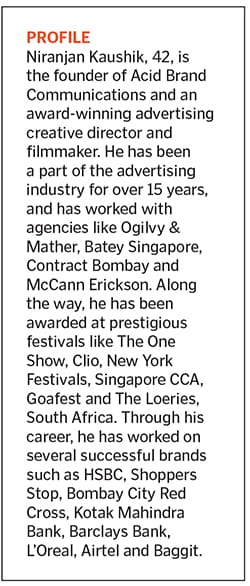India's Mad Men: Who wants to be Don Draper?
The flawed genius of Draper, set against the overtly masculine advertising world of the 1960s in Mad Men, has intrigued and inspired creative professionals for seven years. Now, as the American TV sho
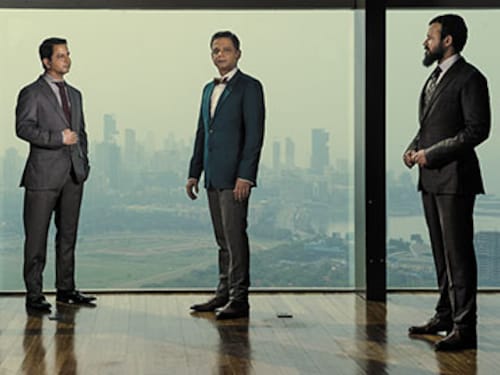

It’s a sunny Christmas in Hawaii, but Don Draper is trapped in one of hell’s nine circles. He’s reading Dante Alighieri’s The Inferno: ‘Midway in our life’s journey, I went astray/ from the straight road and woke to find myself/alone in a dark wood.’ This was at the beginning of the sixth season of Mad Men, a 1960s American period drama on the lives of the men and women who work at Sterling Cooper & Partners ad agency in Manhattan.This was also the season where Draper’s life begins to unravel. The decline is not the manic frenzy that defined the last hours of Walter White (in Breaking Bad) or your friendly neighbourhood serial killer, Dexter. It is the quiet desperation of a man on the verge of losing everything.
It is still unclear whether the writers of that show will allow their lead character, Draper, redemption. But in its ongoing seventh and final season, there is a sense of calm urgency that suggests, at the least, a fightback to a semblance of his previous, all-powerful self. There are only seven episodes left—to be aired later this year—to find out how it all ends for Draper, the self-destructive creative director played by Jon Hamm.
Not many care about Draper, as in feel affection for him. It is difficult to. He wears his abundance of vices like a badge of honour, and is often revealed as a part tragic-part despicable figure. But he is also shown as a genius who, for many professionals, represents an age where advertising was not ‘just a job’ but an intensely creative and coveted calling. It was a time when even the ‘creative’ types wore a suit to work (and would be mistaken for investment bankers today).
The many shades of grey have often rendered the character obnoxious. However, Draper’s talent has proved as aspirational as the products he pitches, as ForbesLife India found out through a number of interviews with advertising professionals in India. The new generation of creative directors envies Draper’s skill at mesmerising clients with his slick pitches. For instance, revisit the man we meet in the first episode of the first season. He’s struggling for an idea for Lucky Strike cigarettes. But he’s buoyed by egotism and confidence. His eyes betray excitement, not the self-loathing of the later seasons. He ends the pitch with what remains one of the most powerful quotes in the series. “Advertising is based on one thing, happiness. ...Happiness is the smell of a new car. It’s freedom from fear. It’s a billboard on the side of the road that screams reassurance that whatever you are doing is okay. You are okay.”
But Draper is no longer okay. Season six rips apart the carefully constructed lie that is his life, and the audience bears witness to the devolution of a man they were convinced was a genius. “He’s still a genius, but a conflicted one. It’s not that he is de-evolving as much as he is unravelling,” says Sayantan Choudhury, senior creative director at JWT, Delhi. “He’s the biggest a**hole, but he is also capable of making some of the sweetest gestures. There’s only so much a man can hold together with so many demons.”
Draper’s conflicts also underscore the ugliness of the advertising industry in the 1960s. Underneath the veneer of crisp suits and gelled hair, Mad Men hyperbolises a period in US history that venerated masculinity, celebrated smoking and alcoholism, accepted and perpetuated racism, condoned anti-Semitism and revelled in adultery. Draper, a product of this period, thrives in its excesses and lives a life without restrictions.
Preeti Vyas Giannetti earned her stripes in a similar world. “Mad Men portrays a period in America that is similar to what I experienced in the Indian advertising industry in the 1980s and 1990s,” says the chairwoman and chief creative officer of Vyas Giannetti Creative (VGC). As a rookie, she worked with advertising legend Mohammad Khan, who introduced her to a world “filled with Don Drapers”. “Yes, there was promiscuity and drunken launches, but there was also passion. It wasn’t just a job. These men were personalities who were driven by a hunger to become trendsetters. But the rules of that decade are no longer valid,” says Vyas Giannetti.
(Talha Bin Mohsin - Suit: Brooks Brothers Shirt: Bombay Shirt Company Pocket square, shoes and belt: Ermenegildo Zegna. Niranjan Kaushik - Suit, shirt, shoes and belt: Ermenegildo Zegna Tie: Brooks Brothers Cufflinks: Hackett London. Denzil Machado - Suit, trousers and cufflinks: Hackett London Shirt: Park Avenue Tie: The Collective Shoes: Steve Madden Belt: Ermenegildo Zegna. Anuraag Khandelwal (on the cover) - Suit, belt and shoes: Ermenegildo Zegna Shirt: Bombay Shirt Company Styled by: Nisha Kundnani Assisted by: Baishali Baruah Hair & Make-up by: Avni Rambhia Location courtesy: Palladium Hotel)
Elsie Nanji, who was creative director and partner of Ambience Advertising for 20 years, also identifies with this overtly masculine world. “When I travelled abroad for creative meetings, I was the lone woman among 12 men. In India, too, it was common for big accounts to go to men, especially if the product was related to technology, like a computer, or something very obvious such as a bike. Clients sought out women only if it was for fashion or cosmetics,” she says. “However, I was often told that my presence was beneficial, not just because I brought another perspective, but also some dignity. After a few drinks, an evening dinner could degenerate into a boys’ club. If they were at a bar, they would try to pick up women. They were being men.” (Nanji is currently managing partner of design firm Red Lion.)
But 1969, the year the final season of Mad Men unfolds, is also the decade’s last hurrah in the US. Society, by then, had started changing into the more politically correct world we know today. And change has come to India, too.
Today, there are plenty of women in ad agencies, but the upper echelons are still dominated mostly by men. Women like Vyas Giannetti and Nanji are among the exceptions, not the norm. And while the industry may have shed its vices and rewritten the rules, it has forgotten the meaning of passion, says Vyas Giannetti. “We are driven solely by the bottom line. We are not leaders anymore but have become followers, with clients as the decision-makers. The moral degradation of the present times is that overpaid kids submit ads just to win international awards. This is not what advertising is about. We are being dictated by a hunger for awards at any cost, and in the process we have become an inward-looking community with no passion.”
In the Mad Men universe, Draper is being buffeted by the winds of change too. The suffragette movement is gaining ground, and Peggy Olsen (Elizabeth Moss)—she was his secretary—is now the boss. His position of power is being eroded.
Nanji, who was drawn to Mad Men in the initial seasons, finds his personality rather unattractive. “He’s a good-looking, smart, creative guy, but he is dishonest. He keeps everyone, his wife, girlfriends, and even clients, at a distance. He doesn’t understand softness, and is incapable of comprehending what a woman can bring to the table. At least not in the episodes that I’ve seen.”
Even Hamm has little sympathy for the character he plays. In a 2013 interview to The Guardian, he says, “People tell me they look up to Don, like they look up to Tony Soprano or Walter White…Maybe it is the fact of doing everything wrong and getting away with it.”
But Draper has started feeling the consequences of his actions. It had to happen. Because Mathew Weiner, the show creator, does not ignore history. Though the series explores the lives of the characters, it remains true to historical events. The 1960 US presidential election, which pitted Richard Nixon against John F Kennedy, runs through the first season. In the second episode of season two, called ‘Flight 1’, Pete Campbell’s father is on American Airlines Flight 1, which in real life crashed on March 1, 1962. The assassinations of Kennedy and Martin Luther King Jr, the death of Marilyn Monroe and the Vietnam War, play out in the backdrop. Technology, too, is evolving, and the ad agency gets an IBM computer in season seven. The Apollo II mission features prominently in the final season. Draper is back at Sterling Cooper, and after a few hiccups, is supportive of Peggy in her new role as copy chief. He, Peggy, Harry and Pete watch the ‘Moon Landing’ in a hotel room at Indianapolis the day before an important pitch. Draper convinces Peggy to give the presentation and they, later, celebrate its success.
Moments like these imply that, perhaps, the man will not only survive the series finale, but emerge once more resurrected at the top.
Whatever the endgame, India’s mad men will be watching. And some of them wistfully. As advertising director and filmmaker Niranjan Kaushik, who has long been drawn to this sepia-tinted world where men and women look like they’ve stepped out of a fashion magazine, puts it: “I was born three decades too late, and working in the wrong continent.”
And Kaushik’s voice is reflected in three others from his fraternity, as you will see in the pages that follow.
(Niranjan Kaushik - Blazer, shirt and tie: Brooks Brothers Pocket square, trousers, shoes and belt: Ermenegildo Zegna. Denzil Machado - Suit and shoes: Ermenegildo Zegna Shirt: Park Avenue Tie: The Collective. Anuraag Khandelwal - Blazer and belt: Ermenegildo Zegna Shirt: Brooks Brothers Tie and cufflinks: Hackett London Shoes: Zara. Talha Bin Mohsin - Waist coat, shoes, trousers and belt: Ermenegildo Zegna Shirt: Brooks Brothers Pocket square: Lacquer Embassy)
I love the fact that the American cable network AMC made a show that was honest and real. Mad Men appears to be an accurate reflection of the period it portrays, the US advertising industry in the 1960s.
The styling is amazing and the detailing is fantastic. Even the magazines the characters in the show read are originally from that time. It’s like watching a documentary on advertising at the time, one that is far more stylish.
Whatever I’ve read or heard about the advertising culture during this period is depicted in Mad Men: The hedonistic lifestyle, ethical lapses, burgeoning feminist movement, racism, political incorrectness and, let’s not forget, the great American dream. It’s all there.
It makes you realise how much the advertising industry has changed since then. It’s not the same anymore. There’s more work and less play.
On the positive side, we have far more mediums to express our ideas. The nature of our job has become more challenging because trends are changing by the hour and new technology is being developed every day. And because of the internet and social media, people are aware of what’s happening in the world today. That was not the case fifty years ago.
The negative, however, is that most advertising agencies these days do not enjoy a partnership with their clients the way it is depicted in Mad Men. It has become more of a client-vendor relationship. Fortunately, there’s one thing that has not changed, and hopefully it will never change: You still need a big idea and bigger b***s to sell it. And some people are still doing it.
There will always be room for a Don Draper. He’s an exceptional creative director, even though he is flawed and insecure. I think this makes the character all the more real. There’s no denying his genius and his ability to captivate his clients when he pitches to them.
I loved most of Draper’s presentations, but I think the Kodak Carousel scene is incredibly powerful. It took place in the first season, but remains one of the best pitches in the series. In the scene, Draper presents a campaign for a slide projector manufactured by Kodak, using photographs of his family. In a darkened room, he flips from image to image through the projector.
And, through wisps of smoke from a lit cigarette, we see pictures of Draper sharing a hot dog with his wife, laying his head on her lap while she’s pregnant with their child, lying down on a couch with their daughter and son.
With each click, with each new memory, he tells the client, “…In Greek, nostalgia literally means ‘the pain from an old wound’. It’s a twinge in your heart, far more powerful than memory alone. This device isn’t a spaceship. It’s a time machine. It goes backwards, forward. It takes us to a place where we ache to go again. It’s not called the wheel. It’s called the carousel. It lets us travel the way a child travels. Around and around and back home again to a place where we know we are loved.”
With each passing moment, we see in Draper’s eyes the realisation of what he has destroyed along the way. I find this to be a moving scene. It’s one of the reasons why Don Draper remains such a sympathetic character.
You see facets of the man in the industry. I’m fortunate enough to have worked with ‘old school’ creative directors, people who dared to defy the rules. Once, in a pitch meeting, just like Draper, my ex-national creative director gave his business card to our own agency account executive thinking he’s the client.
I’ve had many ‘aha’ moments while watching the series. But the one that’s most memorable is when Roger Sterling (founding partner) tells Draper, “The day you sign [on] a client is the day you start losing them.”
This is a lesson for advertising agencies the world over. The business is about doing everything in your power to guard against losing your client. It is a challenging world because the pressure never relents. Your idea has always got to be better than the last one. It’s not just about your initial thought or winning the pitch it’s also about having a long-term vision, so that your relationship with your client lasts. And, above all, it’s about never resting on your laurels.
The camera plays as much a role in telling the story of the people who work at Sterling Cooper. Every frame is immaculately constructed. The cinematography is brilliant, at times dramatic. Some of the more telling shots are the ones that capture Don Draper alone. For instance, when he’s sitting on his bed and the camera slowly moves out of the room. The viewer becomes a voyeur. In India, we tend to use still shots, but in this series the camera sometimes moves into a scene, especially in restaurants and bars.
It’s my job to create the look and the feel of a commercial or a print ad, and it’s this aspect of Mad Men that appeals to me the most. The way each episode is shot is a good reference point for filmmakers.When I first heard about the series, I thought it would be an in-depth portrayal of the advertising industry, but when I started watching it, I realised that it was not the case.
Mad Men is more about the personal lives of the characters, the men in their suits. In many ways, the ad business is a peg, a narrative hook, around which their lives revolve. But even though it only scratches the surface of the ad industry, the show is still a telling account.
At Sterling Cooper, the person whose job profile most resembles mine is an Italian American, Salvatore Romano. He is a quiet person when compared to the other people in the agency, but I do not identify with him, apart from the work that he does.
Nor am I a fan of Don Draper or the way he lives his life. I feel bad when he cheats on his wife. But I do admire the way he pitches an idea to a client. He is confident and articulate in front of the client, and he has to be. In the lipstick scene (in season one), Don and his team present an unusual idea to a cosmetic company. Instead of showing hundreds of lipstick colours, which is what the client wants, his campaign has a woman choosing one lipstick from a “basket of kisses”, the one colour that will make her unique and live up to the tag line, ‘Mark your man’. The client is not impressed, and argues that women want more colours. Don defends his pitch with an eloquence that few people have. He says, “Every woman wants choices but, in the end, no one wants to be one of a hundred in a box.”
This scene highlights an important rule: If you walk into that conference hall nervous, the client will smell it on you. There is no room to second guess your idea. If you do, you will fail.
People like Prasoon Joshi (chairman, Asia Pacific, & CEO of McCann Worldgroup India) and McCann’s national creative directors, Pradyumna Chauhan and Prateek Bhardwaj, have this innate confidence in their ideas. I’m not as articulate as they are, and I admire the way they work. You need to understand the consumer’s life, what makes him or her happy… and only then will your campaign work. And you have to be willing to take risks.
For instance, in the Nestle ‘Share Your Goodness’ campaign, Prasoon had a wonderful idea of showing a girl from the north-east (India) being adopted by a north Indian family. For a Nescafe ad, Prateek and Pradyumna came up with the concept of using a struggling comedian—one who stammers—as the hero of the commercial. Both these campaigns were successful and had a huge impact. They connected with Indians. When you sell an idea, it’s not about who you are, but who the client’s target audience is.
Mad Men showcases this aspect of the industry very well. And that’s what I like about the show.
Elsie Nanji hired me when I was barely out of LS Raheja School of Art, Mumbai. At the time, Nanji, who is now the managing partner at Red Lion, was partner and creative director of Ambience Advertising. I’ve worked with Divya Thakur (founder of Design Temple) and Malvika Mehra (national creative director and senior vice president, Grey India). In not so many words, women have shaped my career. They’ve toned down my stubbornness. And because of my experience, I found the hyper-masculine world of Mad Men and the rampant misogyny it portrays shocking.
In many ways, it’s very typically American, especially in the 1960s, before the feminist movement took off. And even today in popular culture, it’s the male super heroes who are expected to save the world.
I’d like to think that the Indian advertising industry is not sexist. Women hold key positions but, yes, the male-female ratio at the national creative director level is skewed and biased towards men by a 7:1 ratio, but that’s just my guess. I could be wrong.But for all its sexism, it is fascinating to see Don Draper’s ideation process. He often looks to the past or into his own life for inspiration. And this is something I find myself doing. Around two years ago, we had to create a campaign for IPL, and 14 of us spent days brainstorming for a perfect theme. I was going mad. It reminded me of an episode in season six when Don and his team spent a weekend on the Chevrolet pitch. I can identify with that level of frustration. After one hectic ideation day, I returned home at night and, as I was going to bed, I picked up a fairytale book my daughter was reading at the time. As I flipped through the pages, I saw a picture of a boy and girl going to a carnival, and suddenly everything fell into place. The IPL is a carnival, and despite the glamour and the Bollywood quotient, it is a celebration of cricket. Our clients loved the pitch.
Advertising is an industry that forces you to confront who you really are. It is an industry where you have to let your true character come out you can’t suppress it forever. And that’s what Draper is doing.
The dreams that we create sometimes have a kernel of reality or truth in them. I believe that to be successful, you need to be comfortable with who you are. I don’t think Draper is happy with what he was or what he has become. Every time he tries to confront himself or gives in to introspection, he fails. There are too many lies, too many missteps. And with each passing season of Mad Men, you see his dominating personality being chipped away at. But for all his faults—and there are many—I want to believe that he is a good man, a moralistic but confused person. His actions and choices weigh heavily
on him especially in the later episodes.
Ours is a business of egos, and, in many ways, Mad Men acknowledges that. Draper may be the main character, but the other people in the show are also very real.
For instance, I see a lot of Pete Campbells (who starts out as an accounts director) in the industry. The Petes in the advertising world are insecure, but they crave power. They are ambitious, but seek constant validation. I was a Pete Campbell once in the early days of my career. Luckily, I had very good mentors and, today, I’m confident about who I am. And I’m also curious about Draper’s evolution, and what’s in store for him.
I hope he lands on his feet one last time.
I hate Mad Men. No, wait, hate is a mild word. I detest it. Around five years ago, when I was executive creative director at McCann Erickson (India), I went through a marathon 10 episodes of the first season over a long weekend. I was drawn to this highly stylised world of 1960s Manhattan, where well-dressed men with their side-parted hair clad in dark two-piece suits and white shirts created ads for clients.
The following Monday, I got a heavy dose of reality when I went back to work. And that reality was everything Mad Men was not. I was surrounded by some of the most ill-behaved and worst-dressed people amongst the salaried class in Mumbai, a true reflection of the Indian advertising industry. And I’m as guilty as my peers.
Mad Men was a slap in the face. It forced me to acknowledge that little voice in my head, ‘This is what you could have been’. I was born three decades too late, and working in the wrong continent.The show unabashedly embraces a now politically incorrect male chauvinism, but in portraying that, Matthew Weiner (Mad Men’s creator) has remained true to the decade. The men at Sterling Cooper are heavy smokers and massive alcoholics who do not hide their sexism, racism and philandering. When Roger Sterling suffers two heart attacks, he doesn’t stop drinking or smoking. Oh no. He ends his extra-marital affair instead. It’s a telling comment.
Mad Men works because it is a brutally honest characterisation of a period that I will never know or experience. We live in more politically correct times, and this is definitely hindering, if not killing our creativity. In 2013, JWT India found itself in the eye of a storm when it submitted three Ford Figo ads to the Goafest. One of the ads showed a caricature of the Kardashian sisters bound and gagged in the boot with the tag line, ‘Leave your worries behind’. I wrote about the ensuing fallout—JWT fired Chief Creative Officer Bobby Pawar—for Open magazine. In the 1960s, blatantly sexist ads with tag lines such as ‘Show her it’s a man’s world’ were the norm. Mad Men’s allure lies in the fact that it does not shy away from this.
And in the centre of it all is Don Draper, one of the most complex characters in the history of television. He is a serial cheater and appears to have a blatant disregard for women. But then how do you explain his relationship with Joan (Holloway) or Peggy (Olson)? He hasn’t slept with either of them, yet.
I can identify with the friendship between Draper and Joan. One of my favourite scenes is in season five, where they go to a bar and down drinks and smoke cigarettes like it’s going out of fashion. And they talk and talk. The Carpenters’ ‘Christmas Waltz’ is playing in the background, but, at some point, the lyrics rise to the front, overlaying their conversation: ‘It’s that time of the year when the world falls in love’. Theirs is a beautiful friendship.
Don is a genius he can hold a room. When he pitches to clients, it’s about ego, the confidence, the conviction that his and only his idea is the best. He has a command that in the Indian advertising industry I’ve seen in only one person, Piyush Pandey (executive chairman and national creative director Ogilvy & Mather India).
There’s no denying that advertising is about smokescreens and selling dreams or lies, depending on your interpretation of it. And who better to depict this than the lead character, who is not Don Draper. Lieutenant Don Draper was killed in the Korean War. And his friend, Richard ‘Dick’ Whitman assumes his identity. Don Draper, like the world he represents, is a lie.
First Published: Feb 19, 2015, 06:50
Subscribe Now(This story appears in the Apr 16, 2010 issue of Forbes India. To visit our Archives, Click here.)
